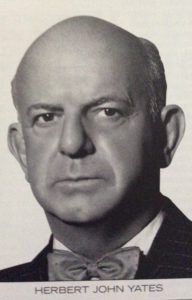In 1935, Herbert Yates showed foresight when he took control of a handful of independent companies producing western films, producers that were under financed and, in some instances, unprofitable. He organized these into Republic Pictures and began upgrading the quality of the films. He steadily improved Republic’s studio lot by staffing it with able technical people. writers and directors. A decade later he rebuilt the studio’s scoring stage into what was the largest and best soundstage of any of the studios. So good was it that major studios rented time there, as did record companies (like RCA Victor), who used it to record their classical artists.
Just about all of Republic’s Western stars were developed by Republic. True, they acquired John Wayne’s contract when Republic was formed but at that point Wayne was making low-budget seven-day wonders. It would be years before he became the biggest star in Hollywood. Yates also acquired Gene Autry’s contract but, at that point, Autry had only starred in two serials.
Two years later, (with Autry now a star with his own series of Western films), when Autry threatened to walk out on his contact, Yates told Sol Siegel (his head of production), to find another singing cowboy. Siegel, who went on (for a different studio) to produce “Three Coins in the Fountain,” “Gentlemen Prefer Blondes” and “High Society,” signed Len Slye, a singer with the Sons of the Pioneers. Len’s name was changed to Roy Rogers, and Roy went on to become the King of the Cowboys.
Yet, as foresighted as Yates was in 1935, he was shortsighted in 1951. Most of the films Republic made were Westerns, especially the Saturday Matinee “B” Westerns that kids (and adults) went to see. But with the emergence of television, instead of waiting for Saturday, suddenly kids could come home from school, turn on the television and watch Westerns with Tim McCoy, Hoot Gibson, Buck Jones and others. True, these were old films from the ’30s and early ’40s, but they were Westerns and they were free and they were right there in their living rooms. The result was a steep and steady decline in Saturday’s theater attendance.
Before long there were new TV Westerns: The Lone Ranger, Adventures of Kit Carson, Wild Bill Hickok, The Cisco Kid and … The Gene Autry Show. When Roy Rogers’ contract with Republic came up for renewal in 1951, Roy was willing to sign a new contract as long as it included his right to appear on television, but Yates was adamant. As far as he was concerned, TV was a novelty. That was what the major studios had thought when sound was introduced. Yates’ aversion to television was the same at all the major studios. At first they ignored it. Not allowing their stars to appear on television, with only an occasional exception to promote their latest film.
Roy knew he had to get into television if he wanted to maintain his popularity. Gene Autry produced his own films independently and distributed them thru Columbia. Being his own boss, he signed with CBS for his own TV series. William Boyd put most of his assets into buying all 66 of the Hopalong Cassidy films he had made and licensed them to TV stations. He made a fortune, as the films became popular all over again. Still, Yates refused to grant TV rights to Roy, so Roy declined to renew his contract with Republic. Instead, he signed with NBC to produce and star in his own series.
The ironic thing is that no studio was better positioned to make Western series for television than Republic. They had mastered the art of making quality films at low cost and on shorter shooting schedules than any other studio. But Yates, this time, was unseeing, and Republic, the studio he had built and developed, began its slow but steady decline until it was only making money by selling its’ old films to television. And then, most ironically, Yates was deposed as head of the studio he had built.
It’s remarkable how an individual can, at one point, be so ahead of the game and a short 16 years later, be oblivious to the fact that the world around his company had changed. Sic transit Republic.
The above story was written by my good friend, Larry Zwisohn. Larry was with 20th Century Fox for years and also spent many years with Mom and Dad’s good friend, Snuff Garrett at Snuff’s company, Nostalgia Merchant. Larry has also done more research into Mom and Dad’s careers and lives than anyone I know. I consider myself very lucky that Larry shares information with me, that I can pass along to you. Cheryl

1 comments
Enjoyed this biopic Cheryl. My education in early films and TV, with a major in Republic Pictures, continues. Thanx for sharing this history……………